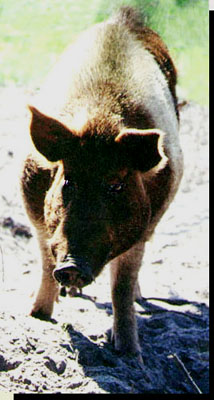American wild boar
are lean and athletic. Compact, high and wide at the shoulder tapering
to the hip, their narrow heads lead to an impossibly long snout.
Ears are smaller, legs longer and coats usually more coarse and dense than
any domestic hog. The back bristles stand on end, peaking at the
shoulder, earning the hogs their name of "razorback". The typical color
is black, but they can have any color, in any pattern. The typical
weight is around 150 pounds, but they can less commonly become much heavier,
to well over 300 pounds.
A boar's Russian ancestry
is prized by many hunters, and inaccurately assessed by about as many.
The single most reliable indicator of a European ancestry is the bristle...the
bristle tips will be a lighter, usually cream, color. The Eurasian
piglets are striped with lengthwise stripes, but so are some domestic piglets.
The Eurasian hog is typically brown with a lighter underbelly and darker
face, legs and ears.
Boars have prominent tusks (Sows have much
smaller ones.) that never stop growing. The upper jaws have the stumpier
"whetters"; the lower jaws the long, outwardly projecting "cutters". The
whetters constantly shear the edge of the cutters (like a whetstone) making
them razor sharp weapons that can fatally puncture an opponent or easily
slice through a 3 inch tree root. The cutters are often worn or broken during
fighting or rooting, but renew themselves with continuous growth and sharpening.
When you see an agitated boar popping his jaws and foaming at the mouth he
is actively honing his most lethal weapon. Hunters who hunt with dogs
fear the 1.5 to 3 inch tusks more than they do the longer ones. While
they are all deadly weapons, the shorter teeth are often sharper and placed
at just the right angle to do maximum damage.
The shield of the wild
boar is his protection from the tusks of his adversaries. It covers
the shoulders and tapers back over his ribs. It is made of cartilage
and scar tissue and thickens and hardens with every injury. Shields
can stop bullets including .44 magnums and .45/70's. Faster modern
bullets, however, like the 30-06, can penetrate a shield. |
